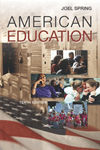|
 |  American Education, 10/e Joel Spring
Feature SummaryNew to This Edition - UPDATED: All chapters were thoroughly updated to guarantee current analysis of the very latest developments in today's educational issues.
- EDUCATIONAL OPPORTUNITY: There are now two chapters on equality of educational opportunity: Chapter 5, "Equality of Educational Opportunity: Race, Gender, and Special Needs," and Chapter 6, "Student Diversity." The new Chapter 5 focuses more clearly and explicitly on issues of race, gender, and special needs. The new Chapter 6 examines the culture of the school and attempts to impose it on other cultures, specifically Mexican-Americans, Puerto Ricans, Asians, and Native Americans.
- STATE AND FEDERAL: The previously separate chapters on power and control of education at the state and national levels have become one chapter called "State and Federal Control of Education." This new Chapter 9 clearly illustrates the differences between local, state, and federal control of schools and examines the role of high-stakes tests in the control of schools.
- ONLINE LEARNING CENTER WEB SITE: An all new OLC features resources for instructors and students, including and Instructor's Manual, Study Tools, and Current Events Activities designed to get students to learn more about what goes on in their state regarding education.
- CONCLUSIONS: Every chapter in the new edition features a Conclusion to help students check their understanding and to begin to explore the implications of chapter material.
Features - FRESH, CONCISE: Revised every two years in order to provide a fresh,
concise, and up-to-date introduction to the historical, political, social,
and legal foundations of education and to the profession of teaching in the
United States.
- CRITICAL THINKING: Challenges students and engages them in analysis
and critical thinking about the role and purposes of schooling in American
society.
- CRITICAL PERSPECTIVE: Introduces students to new ways of thinking
about education: the critical perspective is designed to make the reader think.
- QUESTIONS : Organized by topic, the text integrates, historical, sociological,
and philosophical questions throughout.
- ORIGINAL: Represents original scholarship and interpretation. Scholars
use this text as a primary source.
- BRIEF, AFFORDABLE: The text's modest length and price allow instructors
to combine it with other books for a customized teaching package.
|
|
|



 2002 McGraw-Hill Higher Education
2002 McGraw-Hill Higher Education

 2002 McGraw-Hill Higher Education
2002 McGraw-Hill Higher Education